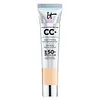What's inside
What's inside
 Key Ingredients
Key Ingredients

 Benefits
Benefits

 Concerns
Concerns

 Ingredients Side-by-side
Ingredients Side-by-side

Titanium Dioxide 9%
Cosmetic ColorantZinc Oxide 6.3%
Cosmetic ColorantWater
Skin ConditioningPhenyl Trimethicone
Skin ConditioningDimethicone
EmollientButylene Glycol
HumectantButylene Glycol Dicaprylate/Dicaprate
EmollientOrbignya Oleifera Seed Oil
EmollientButyloctyl Salicylate
Skin ConditioningCetyl PEG/PPG-10/1 Dimethicone
EmulsifyingCyclopentasiloxane
EmollientSnail Secretion Filtrate
Skin ConditioningAluminum Hydroxide
EmollientMagnesium Sulfate
Polyglyceryl-4 Isostearate
EmulsifyingStearic Acid
CleansingCyclohexasiloxane
EmollientDimethicone/Vinyl Dimethicone Crosspolymer
Skin ConditioningHexyl Laurate
EmollientCalcium Stearate
Cosmetic ColorantTriethoxycaprylylsilane
Caprylyl Glycol
EmollientEthyl Hexanediol
SolventEthylhexylglycerin
Skin ConditioningLimonene
PerfumingCitrus Limon Peel Oil
MaskingSorbitan Isostearate
EmulsifyingTocopheryl Acetate
AntioxidantPhenoxyethanol
PreservativeCitrus Aurantium Bergamia Fruit Oil
Masking1,2-Hexanediol
Skin ConditioningAdenosine
Skin ConditioningCitrus Aurantium Dulcis Peel Oil
MaskingCitrus Aurantifolia Oil
CleansingPinus Sylvestris Leaf Oil
MaskingLinalool
PerfumingEucalyptus Globulus Leaf Oil
PerfumingGlycerin
HumectantCitral
PerfumingNiacinamide
SmoothingHyaluronic Acid
HumectantColloidal Oatmeal
AbsorbentHydrolyzed Collagen
EmollientSteareth-20
CleansingPentaerythrityl Tetra-Di-T-Butyl Hydroxyhydrocinnamate
AntioxidantCamellia Sinensis Leaf Extract
AntimicrobialOlea Europaea Leaf Extract
PerfumingChlorhexidine Digluconate
AntimicrobialN-Hydroxysuccinimide
Skin ConditioningSilk Extract
Skin ConditioningHydrolyzed Silk
HumectantSodium Citrate
BufferingPotassium Sorbate
PreservativePalmitoyl Tripeptide-1
Skin ConditioningChrysin
Skin ConditioningPalmitoyl Tetrapeptide-7
Skin ConditioningCitric Acid
BufferingBiotin
AntiseborrhoeicTitanium Dioxide 9%, Zinc Oxide 6.3%, Water, Phenyl Trimethicone, Dimethicone, Butylene Glycol, Butylene Glycol Dicaprylate/Dicaprate, Orbignya Oleifera Seed Oil, Butyloctyl Salicylate, Cetyl PEG/PPG-10/1 Dimethicone, Cyclopentasiloxane, Snail Secretion Filtrate, Aluminum Hydroxide, Magnesium Sulfate, Polyglyceryl-4 Isostearate, Stearic Acid, Cyclohexasiloxane, Dimethicone/Vinyl Dimethicone Crosspolymer, Hexyl Laurate, Calcium Stearate, Triethoxycaprylylsilane, Caprylyl Glycol, Ethyl Hexanediol, Ethylhexylglycerin, Limonene, Citrus Limon Peel Oil, Sorbitan Isostearate, Tocopheryl Acetate, Phenoxyethanol, Citrus Aurantium Bergamia Fruit Oil, 1,2-Hexanediol, Adenosine, Citrus Aurantium Dulcis Peel Oil, Citrus Aurantifolia Oil, Pinus Sylvestris Leaf Oil, Linalool, Eucalyptus Globulus Leaf Oil, Glycerin, Citral, Niacinamide, Hyaluronic Acid, Colloidal Oatmeal, Hydrolyzed Collagen, Steareth-20, Pentaerythrityl Tetra-Di-T-Butyl Hydroxyhydrocinnamate, Camellia Sinensis Leaf Extract, Olea Europaea Leaf Extract, Chlorhexidine Digluconate, N-Hydroxysuccinimide, Silk Extract, Hydrolyzed Silk, Sodium Citrate, Potassium Sorbate, Palmitoyl Tripeptide-1, Chrysin, Palmitoyl Tetrapeptide-7, Citric Acid, Biotin
Water
Skin ConditioningDicaprylyl Carbonate
EmollientCI 77891
Cosmetic ColorantEthylhexyl Methoxycinnamate
UV AbsorberHydrogenated Vegetable Oil
EmollientDiethylamino Hydroxybenzoyl Hexyl Benzoate
UV FilterEthylhexyl Triazone
UV AbsorberEthylhexyl Salicylate
UV AbsorberDimethicone
EmollientNylon-12
C20-22 Alkyl Phosphate
EmulsifyingCI 77492
Cosmetic ColorantC20-22 Alcohols
Emulsion StabilisingCI 77491
Cosmetic ColorantBis-Ethylhexyloxyphenol Methoxyphenyl Triazine
Skin ConditioningDiglycerin
HumectantPhenoxyethanol
PreservativeDecyl Glucoside
CleansingTriacontanyl Pvp
HumectantParfum
MaskingChlorphenesin
AntimicrobialXanthan Gum
EmulsifyingMica
Cosmetic ColorantBrassica Campestris Sterols
EmollientO-Cymen-5-Ol
AntimicrobialTocopheryl Acetate
AntioxidantAlumina
AbrasiveSodium Hydroxide
BufferingTriethoxycaprylylsilane
Phytosphingosine
Skin ConditioningRaspberry Seed Oil/Palm Oil Aminopropanediol Esters
Skin ConditioningSilica
AbrasiveBHT
AntioxidantPanax Ginseng Root Extract
EmollientTocopherol
AntioxidantMaltodextrin
AbsorbentTin Oxide
AbrasiveWater, Dicaprylyl Carbonate, CI 77891, Ethylhexyl Methoxycinnamate, Hydrogenated Vegetable Oil, Diethylamino Hydroxybenzoyl Hexyl Benzoate, Ethylhexyl Triazone, Ethylhexyl Salicylate, Dimethicone, Nylon-12, C20-22 Alkyl Phosphate, CI 77492, C20-22 Alcohols, CI 77491, Bis-Ethylhexyloxyphenol Methoxyphenyl Triazine, Diglycerin, Phenoxyethanol, Decyl Glucoside, Triacontanyl Pvp, Parfum, Chlorphenesin, Xanthan Gum, Mica, Brassica Campestris Sterols, O-Cymen-5-Ol, Tocopheryl Acetate, Alumina, Sodium Hydroxide, Triethoxycaprylylsilane, Phytosphingosine, Raspberry Seed Oil/Palm Oil Aminopropanediol Esters, Silica, BHT, Panax Ginseng Root Extract, Tocopherol, Maltodextrin, Tin Oxide
 Reviews
Reviews

Ingredients Explained
These ingredients are found in both products.
Ingredients higher up in an ingredient list are typically present in a larger amount.
Dimethicone is a type of synthetic silicone created from natural materials such as quartz.
What it does:
Dimethicone comes in different viscosities:
Depending on the viscosity, dimethicone has different properties.
Ingredients lists don't always show which type is used, so we recommend reaching out to the brand if you have questions about the viscosity.
This ingredient is unlikely to cause irritation because it does not get absorbed into skin. However, people with silicone allergies should be careful about using this ingredient.
Note: Dimethicone may contribute to pilling. This is because it is not oil or water soluble, so pilling may occur when layered with products. When mixed with heavy oils in a formula, the outcome is also quite greasy.
Learn more about DimethiconePhenoxyethanol is a preservative that has germicide, antimicrobial, and aromatic properties. Studies show that phenoxyethanol can prevent microbial growth. By itself, it has a scent that is similar to that of a rose.
It's often used in formulations along with Caprylyl Glycol to preserve the shelf life of products.
Tocopheryl Acetate is AKA Vitamin E. It is an antioxidant and protects your skin from free radicals. Free radicals damage the skin by breaking down collagen.
One study found using Tocopheryl Acetate with Vitamin C decreased the number of sunburned cells.
Tocopheryl Acetate is commonly found in both skincare and dietary supplements.
Learn more about Tocopheryl AcetateTriethoxycaprylylsilane is a silicone used to bind and stabilize ingredients.
As an emulsifier, it helps prevent ingredients from separating. This can help elongate the shelf life of products.
Triethoxycaprylylsilane is often used to coat mineral sunscreens ingredients to help give a better feel. It also helps reduce oxidative stress in sunscreens.
Learn more about TriethoxycaprylylsilaneWater. It's the most common cosmetic ingredient of all. You'll usually see it at the top of ingredient lists, meaning that it makes up the largest part of the product.
So why is it so popular? Water most often acts as a solvent - this means that it helps dissolve other ingredients into the formulation.
You'll also recognize water as that liquid we all need to stay alive. If you see this, drink a glass of water. Stay hydrated!
Learn more about Water